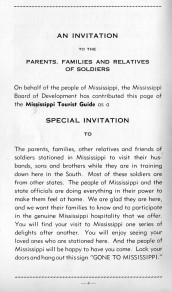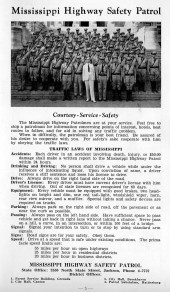Although it seems like heading out on the highway has been a part of American life forever, in fact, it was only in the 1930s that a system of paved roads made it easy for average middle-class people to venture out in their new family cars to see the country. Mississippi’s highways had made great strides in the last half of the Great Depression, from the graveled, only-connected-on-a-map system of country roads and city streets, to a sure-nuff network of graded and paved highways that criss-crossed the state and finally started to give the railroads some competition (of course, the highways were publicly funded, while the railroads were owned and maintained by. . . well, at least mostly private companies, so some would say that the competition wasn’t really fair, but that’s a topic for another day).
A little while ago, a friend handed me this booklet, Mississippi Tourist Guide, published by the Mississippi State Board of Development’s Advertising and Industrial Division around 1941, and probably provided on request to travelers. (I don’t know that we had any welcome centers yet to hand them out in, but that would also be a topic for another day.) The message from Governor Paul B. Johnson hints at other targets of this marketing campaign: industries and home seekers.
The booklet touts the new paved highways and devotes several pages to each, including a brief description of the character and topography of the highway, a map, and blurbs about the major towns a traveler would pass through. Because of the Jim Crow era, the guide is marketed to white travelers while avoiding the subject of race. Nevertheless, I thought it was worth re-publishing here on MissPres, not only because of the individual highway histories (a topic for a book if only someone at MDOT would write it) and the interesting photos it contains but also for the peak into the early marketing of Mississippi’s historic sites, only a few years after the first Natchez Pilgrimage.
Today, we’ll get started with the introductory material and then we’ll move on to the individual highways in subsequent posts. At some point I’ll also put the pages together into a pdf that you could read all at once, should you so choose.
A Personal Invitation
April 28, 1941
GREETINGS TO TOURISTS:
We neither propose nor need to use high pressure methods of salesmanship to entice additional industries or home seekers to Mississippi. On the contrary, our position and attitude are express in the simple invitation, “Come and see.”
Citizens of Mississippi will take pride in showing you many beautiful ante-bellum homes, the finest long-staple cotton in the Nation, long-leaf yellow pine forests, the country’s largest tung oil industry, a park system which includes many recreational centers, unusually attractive church and school facilities, and our beautiful Gulf Coast, where outdoor life is enjoyed through the year. Modern, paved highways, consisting of approximaely 3,000 miles, will also be found.
COME AND SEE!
Paul B. Johnson,
Governor
A whole different group of travelers appears on page 4 as war looms in the background of this otherwise sunny and cheerful presentation of the state. World War II was, to say the least, a boost for Mississippi’s economy, as dozens of military training installations were built around the state and Camp Shelby ballooned with thousands of troops getting ready to deploy:
AN INVITATION TO THE PARENTS, FAMILIES AND RELATIVES OF SOLDIERS
On behald of the people of Mississippi, the Mississippi Board of Development has contributed this page of the Missississippi Tourist Guide as a
SPECIAL INVITATION
TO
The parents, families, other relatives and friends of soldiers stationed in Mississippi to visit their husbands, sons and brothers while they are in training down here in the South. Most of these soldiers are from other states. The people of Mississippi and the state officials are doing everything in their power to make them feel at home. We are glad they are here, and we want their families to know and to participate in th genuine Mississippi hospitality that we offer. You will find your visit to Mississippi one series of delights after another. You will enjoy seeing your loved ones who are stationed here. And the people of Mississippi will be happy to have you come. Lock your doors and hang out this sign, “GONE TO MISSISSIPPI.”
The Introduction also includes a whole page dedicated to the history of the Old Capitol, an indication that by the 1930s, the building had become an acknowledged icon of the state and a tourist attraction.
THE OLD CAPITOL
The Old Capitol has been the theater of the most turbulent events in the history of Mississippi. Its corridors have echoed to the tread of some of America’s most illustrious statesmen. It has been alternately the scene of turmoil, tragedy and final triumph. It has lived through a century unmarked by the ravages of time [this is blatant hyperbole since it sat vacant and deteriorating for 13 years after the New Capitol was built, a period during which it lost its roof in a 1909 hurricane.]
Described as one of the most perfect examples of antebellum architecture, the Old Capitol was begun in 1833, occupied while still unfinished in 1839 and completed in 1842. The total cost was $400,000.[1] Much of the construction work was done by slave labor. Brick for the massive walls were burned in nearby kilns. Long leaf yellow pine lumber was sawn from the then near virgin forests of Simpson and Smith counties and hauled to Jackson by ox teams. Copper used to cover the dome was transported by similar method from New Orleans.[2]
First striking incident in the century-old story of the building was the visit of Andrew Jackson in 1844. Another famous statesmen [sic] to visit the Old Capitol was Henry Clay. And in 1847 Jefferson Davis, returning triumphantly at the head of his regiment from the Battle of Buena Vista, addressed the multitude from the balcony.
Some of the most dramatic events connected with the War Between the States and its aftermath took place within the walls of this building. Here, on January 10, 1861, the secession ordinance was passed.
In 1884 Jefferson Davis made his last public appearance here when he addressed the legislature.
In 1903 with the completion of the New Capitol, the historic Old Capitol was superseded, but it stands as a permanent memorial to a century of Mississippi progress.
Stay tuned next week for The Old Spanish Trail (U.S. 90).
Back to post 1 I don’t believe this is an accurate number–see “Repairing the Old Capitol, 1916-1917.”
Back to post 2 Or maybe by river??
Categories: Antebellum, Heritage Tourism, Historic Landscapes









recent nostalgia, for sure— and, i’ll jump right in to make a few comments since i suspect we’ll have a lot of responses. haven’t seen this brochure before, so i know i will enjoy it’s pages.
it is interesting that there is a ‘war message’ even though this seems to have been published shortly(?) after late april, 1941—dec 7, 1941, pearl harbor day, was still a few months away.
my mother’s family, in hatiesburg, knew all of the johnson family from the beginning of their rise to prominence to the present. and, my own parents are ‘my parents’ because they met in hattiesburg when my father–a native of california–was stationed at camp shelby. she was not the only mississippi woman to ‘marry out of state’–some of these war brides left ms for other places, but my parents chose to live in ms after my father completed his grad school studies in ca that had been interrupted by ww2
LikeLike
Ed~
Maybe the writers had been aware of the role that FDR and Ben Cohen had in the planning for a backdoor war against Germany that began in the late 1930s?
Charles Lindbergh delivered his famous 11Sep1941 speech at Des Moines, Iowa on the shipment of billions of dollars of war materials–on credit– to the Soviet Union through the Lend-Lease legislation crafted by Cohen. And in June of of 1941, FDR issued an executive order for the US Army and the Army Air Force to attack and destroy German shipping in international waters.
Lindbergh’s 9/11 speech is still available on YouTube. Cohen’s role in crafting this legislation can be found in the unauthorized biography by William Lasser: Ben V. Cohen: Architect of the New Deal.
After reading USM Professor Morgan’s book, Theodore Bilbo; Redneck Liberal of the New Deal, I would suspect Senator Bilbo, rather than Cohen, should hold that”architect” title.
Still puzzled as to the connections that Bilbo had with the world famous German Sculptor Fiitz Behn who created then Bilbo bronze statue which Winter removed from the Capitol Rotunda building and dumped into Room 113
LikeLike
Very much looking forward to this new series!
LikeLike
This booklet is a treasure box! Thank you for sharing!
LikeLike